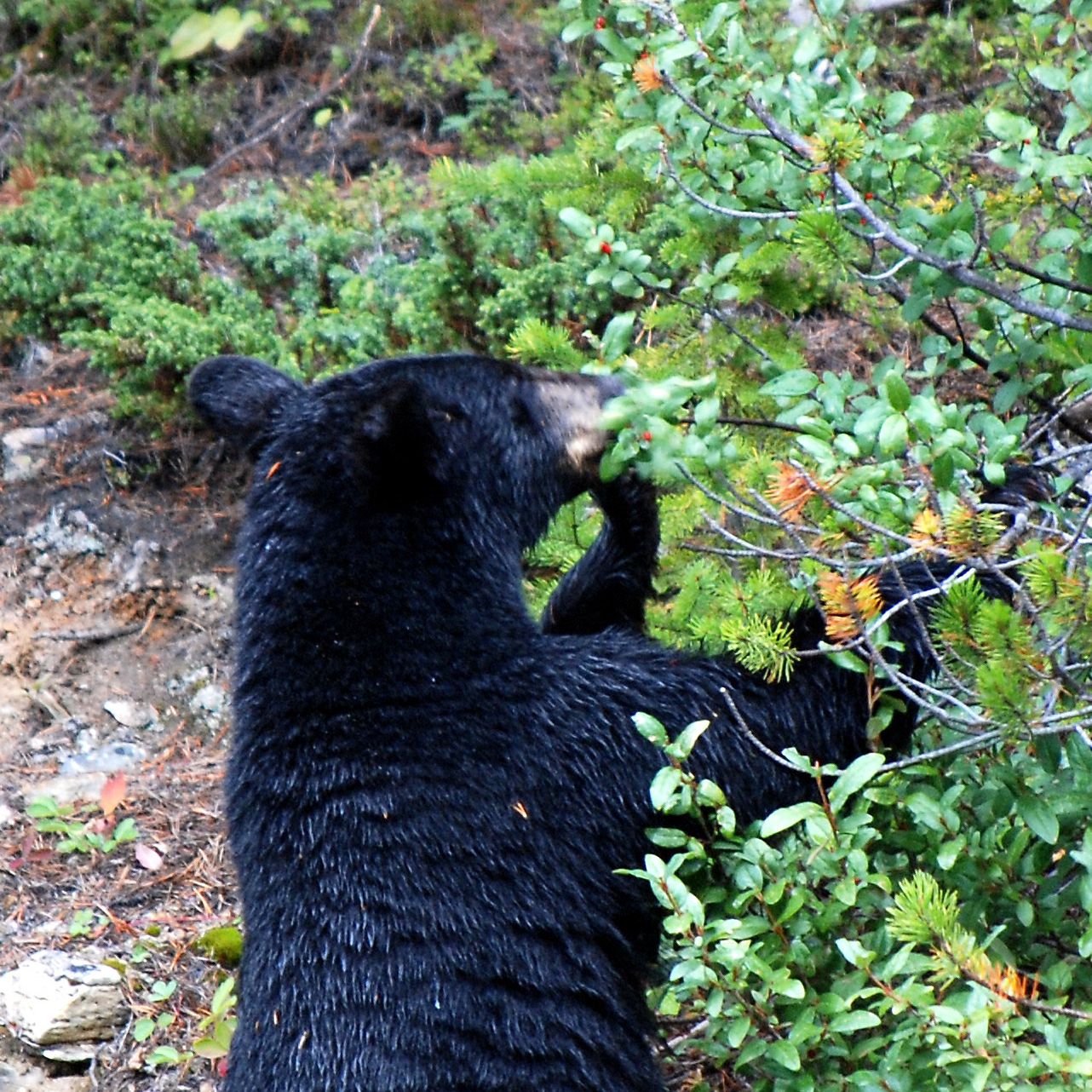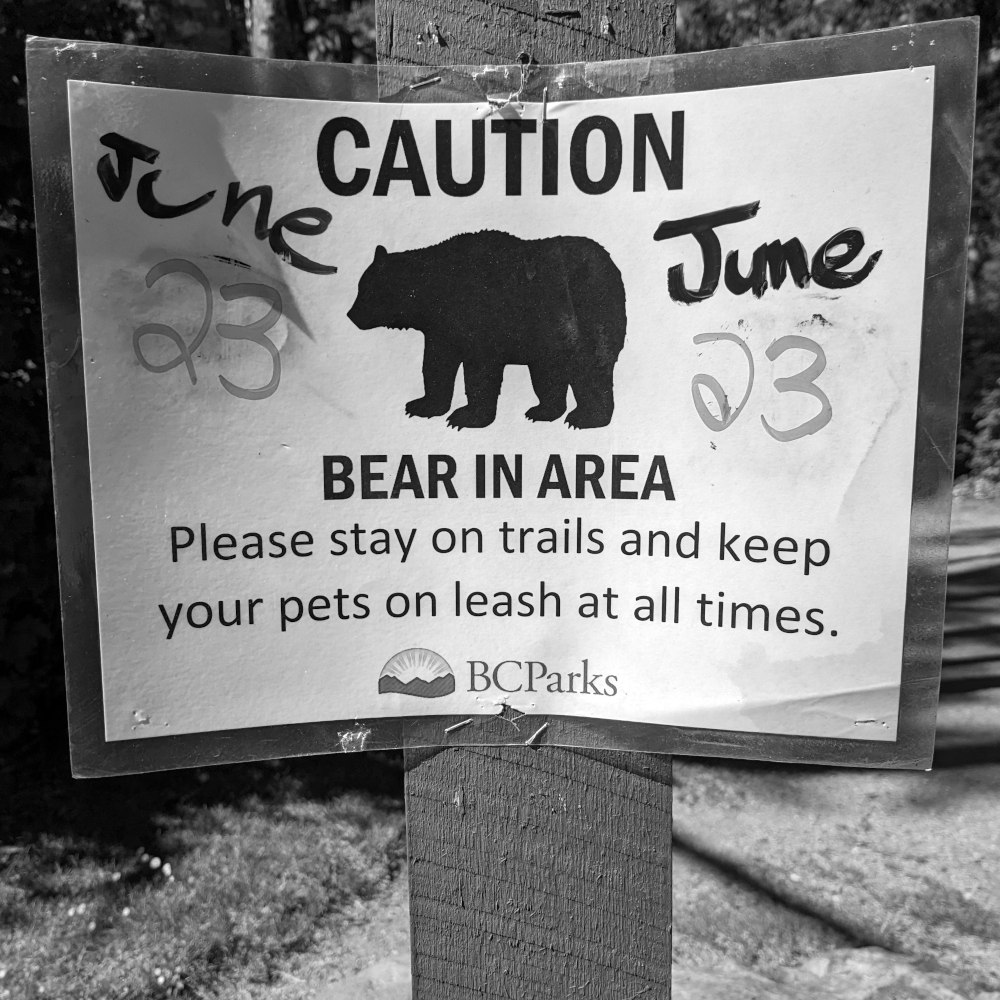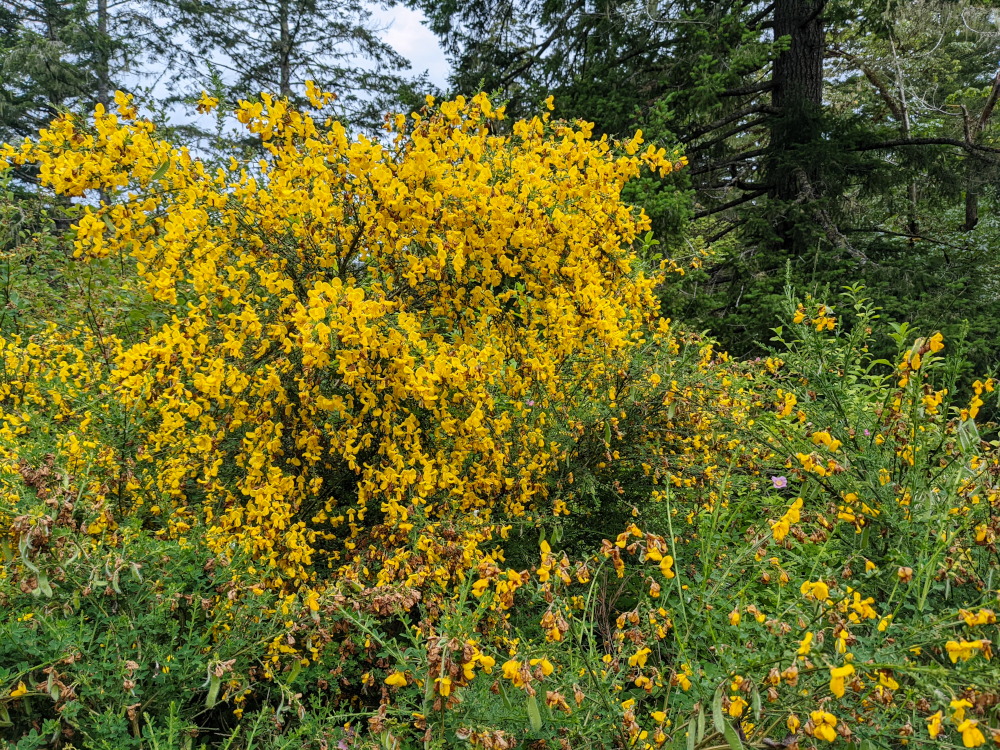Bears, Broom, and the Tale of Two Johns
PeriBlog I: Sooke, British Columbia, Canada. June 28, 2022

Black bear. Photo courtesy California Department of Fish and Wildlife, Sacramento, CA, USA.
Here There Be Bears
This blog post comes to you from near Sooke, British Columbia. Occupying a small, one bedroom house on the north side of the Strait of Juan de Fuca, we have been watching ships, wind-surfers, and an astonishing variety of wildlife from our large wall of windows. It’s not the ocean, but occasionally, when a Pacific breeze rips down the Strait, snapping the Canadian maple-leaf flag planted in our neighbor’s yard, the waves pick up and throw white spume over the boulderous seawall.
A mink lives somewhere among these rocks; he likes to slip out from beneath the seawall in the morning, take a swim in the saltwater, and then return to his hiding place. A bald eagle observes events from a branch in a nearby fir tree, and sea otters, like mouthy junior high school students walking home from the bus stop, swim past in packs, snatching fish from the kelp beds and then flipping on their backs to gobble their fresh sushi.

Afternoon clouds, Strait of Juan de Fuca. All photos, unless otherwise indicated, are by the author.
Canada’s Highway 14, the road to Port Renfrew runs past on the landward side of our house, but it is lightly traveled, and doesn’t take away the sense of wilderness and wild spaces that pervades our near-Sooke hideaway.
Of course the most impressive wildlife in these parts — that we have seen — are the bears. Biologists estimate that there are more than 12,000 black bears on Vancouver Island, and we certainly have our share in Greater Sooke. It is fairly common to see them, especially on days of garbage pickup, lurking near the road, hanging like delinquent teens around recycle bins.

The sign says it all. Near Sooke.
Bears and garbage. It is an ongoing problem that is exacerbated when autumn approaches. The bears must consume up to 20,000 calories of food each day to pad their hibernation fat reserves. Human waste is an excellent source of easy calories. This brings them into contact with human habitation, venturing into places they might normally avoid. Placards dot the lawns of homes in Sooke, warning that bears have recently been spotted in the neighborhood.
A man from Alberta, eager to match bear tales, told me that as he and his wife drove across eastern British Columbia, they saw bears eating dandelions by the side of the roads. Late snow still commanded the lower mountain slopes, and the bears had been forced into the river valleys in search of food. A report from the Vancouver Sun (March 25, 2022), however, suggests that this is not unusual behavior; when black bears emerge from hibernation in the spring, they typically are in the mood for roughage — dandelions and grass — to warm up their stomachs before they take on heartier meals, like hikers and slow-moving bicyclists.
Other bears simply go out for pizza.
On a windy Vancouver Island evening, Mrs. G. and I stopped in at a local, wood-fired pizza parlor. Dining was outside, at large peeled log picnic tables. Midway through our meal, one of the waiters brought out an announcement. One of the employees had spotted a bear on the far side of the parking lot (to which our dining area abutted) and he warned us that we might want to stay away from that corner of the property, should anyone feel the need to indulge in a post-pizza perambulation.
And if you have dogs or children, he finished, you might want to keep them close as well.
Another fun bear fact: the province of British Columbia accounts for one out of every three black bear attacks recorded on the North American continent.
Midway through the week, we loaded into the Subaru to drive into Sooke. As I engaged the ignition key, a black bear ambled across the road in front of us, reared up to place his front paws on the concrete crash barrier, then pulled himself up onto the divider. He took a couple of tentative steps, moving along the top of the divider like a clown on an circus high wire, then slid over into the brush alongside the road, falling like a slow-moving avalanche.
Bears as far as the eye can see.
Sooke, I’ve learned, was first inhabited by the T’sou-ke people. Enjoying the region’s natural bounty — berries, salmon, and other fish — they lived a relatively peaceful life, pottering among the trees and running from bears.
When the Hudson’s Bay Company reached Vancouver island, its traders contemplated establishing a trading post in Sooke. They ultimately rejected the idea, believing that the harbor’s hairpin turn was too difficult for sailing vessels to navigate. They set up shop in Victoria, which is now British Columbia’s capital.
In 1851 British Captain Walter Colquhoun Grant was the first European to purchase land on Vancouver Island — and he chose to stake his claim here in Sooke. Historians do not record who sold him the property — probably the jaunty British government which had declared the entire island a new British province. Although he did not stay long — he returned to England in 1853 — some might consider him the founder of Sooke.
An interesting historical sidebar: Grant’s greatest legacy was his decision to brighten the island up a bit. Deeming it a bit dark green and gray, he imported seeds of his favorite yellow flower from the home country and spread them liberally in Sooke. This noxious shrub, the horrifically invasive Scotch Broom (Cytisus scoparius) now grows from Alaska to California. Often found in cleared spaces, it crowds out native trees and is estimated to be responsible for nearly forty million dollars of damage every year.

Scotch broom (Cytisus scoparius), Captain Grant’s lasting legacy.
So, thanks Captain Grant.
An observant visitor to Sooke will quickly realize that many things around here are named after John Muir: Muir Elementary School, Muir Creek, Muir Beach, Muir Mountain, and Muir-maid Rock — sorry, made that one up. I was confused when I first encountered this phenomenon. I’ve always associated naturalist John Muir with the American Southwest, especially Yosemite and the Sierra Mountains. Did environmentally conscious Sooke simply admire the California environmentalist and decide to honor him by naming half the town’s features after him?
Or, was it possible that Muir spent some time — botanizing and chasing bears — in Sooke?
Sandcut Falls. Near Sooke, BC.
Well, knowing that my readers would demand answers once confronted by these tantalizing questions, I dove into the matter.
As it turns out, the nineteenth century hosted two famous John Muirs. America’s founder of the Sierra Club, and the John Muir who became the second great man of Sooke. Let that serve as a warning for all budding historians — always read your wikipedia articles thoroughly before writing a blog post.

“California” John Muir. Library of Congress.
Sooke John, as we might call him to avoid confusion with California John, responded to the Hudson’s Bay Company advertisement for an experienced collier (coal miner/prospector). Traces of the valuable substance had been discovered near Fort Rupert, and the Company thought it would be swell if Sooke John could extract it for them.
Coal mining never developed into a sustainable industry on Vancouver Island, but it did mean that John was here when Captain Clark, having seeded his land with Scotch Broom, was ready to sell out. John purchased Clark’s land and established Woodside Farm. He also began logging the old growth timber, which he ran through the sawmill he established. His timber company soon dominated the area, shipping lumber to ports around the Pacific Rim. In later life, he served as justice of the peace and represented his neighbors in local government. He died April 4, 1883, old and full of his years. He, far more than the broom-planting Grant, was the founding father of the new community of Sooke.
That's the news from Sooke. Join me next week for another exciting report from the Great Green North.
If you are enjoying this series, why not subscribe to Richard's monthly newsletter, What's New in Old News? The Peripatetic Historian is on the road, roaming the world and compiling fresh adventures. Don't miss out. Click here to join the legions of above-average readers who have already subscribed.